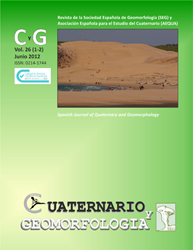División geológico-geotécnica aplicada a la zonación sísmica urbana: San Cristóbal, Cuba occidental
Palabras clave:
Zonación geológica-geotécnica, períodos dominantes, amplificación sísmicaResumen
Se presenta el análisis detallado de las condiciones geológico-geotécnicas de un sector de las llanuras altas y medias meridionales del extremo occidental de Cuba, como base para la caracterización y evaluación del efecto de sitio y, en consecuencia, la identificación de los diferentes niveles de susceptibilidad sísmica en el pueblo de San Cristóbal. La actividad sísmica de esta región está asociada fundamentalmente a la dinámica regional de la falla activa de desplazamiento horizontal siniestro Pinar. Los seismos en el área se caracterizan por una magnitud moderada a débil, focos someros y una baja frecuencia. La metodología empleada constó de 3 tareas: (1) elaboración del mapa geológico-geotécnico, (2) zonación en términos de período dominante, y (3) estimación de la variación de intensidad macrosísmica (∆I). Se ha caracterizado a los grupos litológicos en función de su potencia, velocidad de ondas S, valor-N de ensayos de penetración estándar y la densidad natural de sus materiales. Se propone una zonación en seis clases, según los períodos dominantes de sus materiales; además, se estimaron las ∆I para cada clase. El grupo litológico aluvial reciente y el aluvial marino del Plioceno-Pleistoceno inferior, con espesores superiores a 30 m, presentan la mayor capacidad de amplificación sísmica.Descargas
Los datos de descargas todavía no están disponibles.


